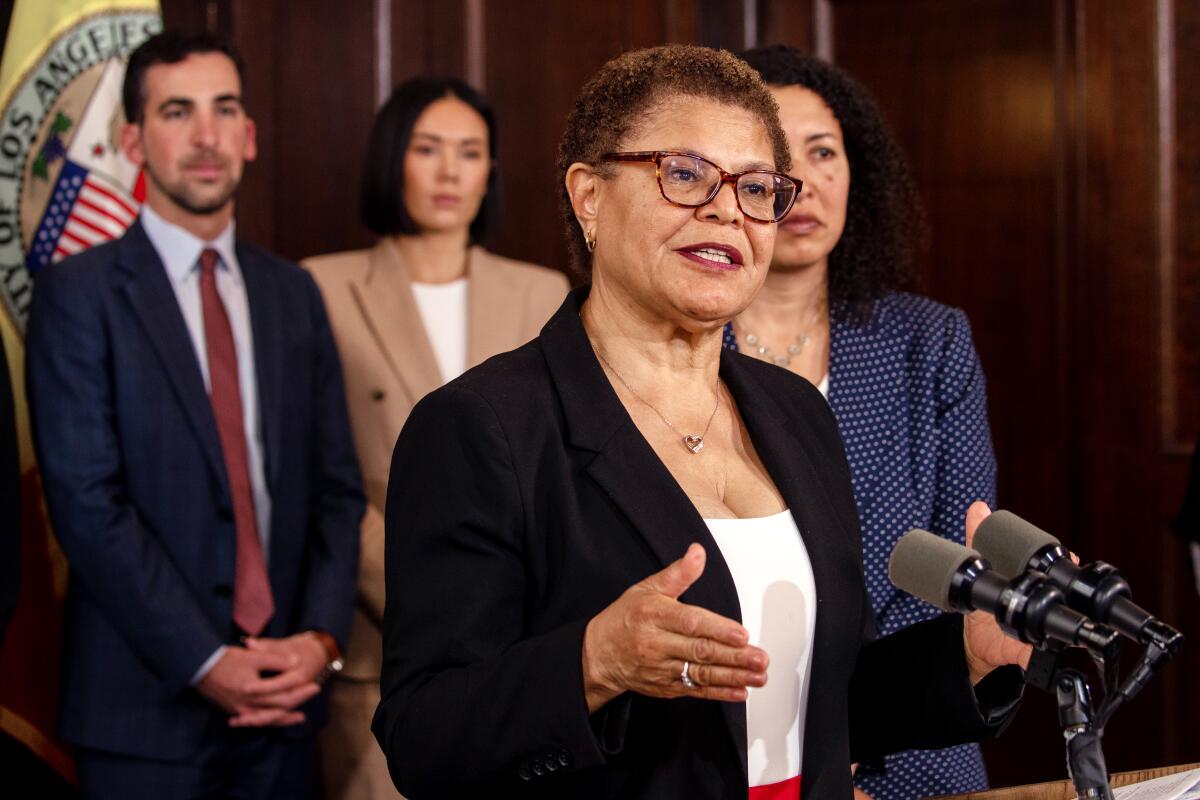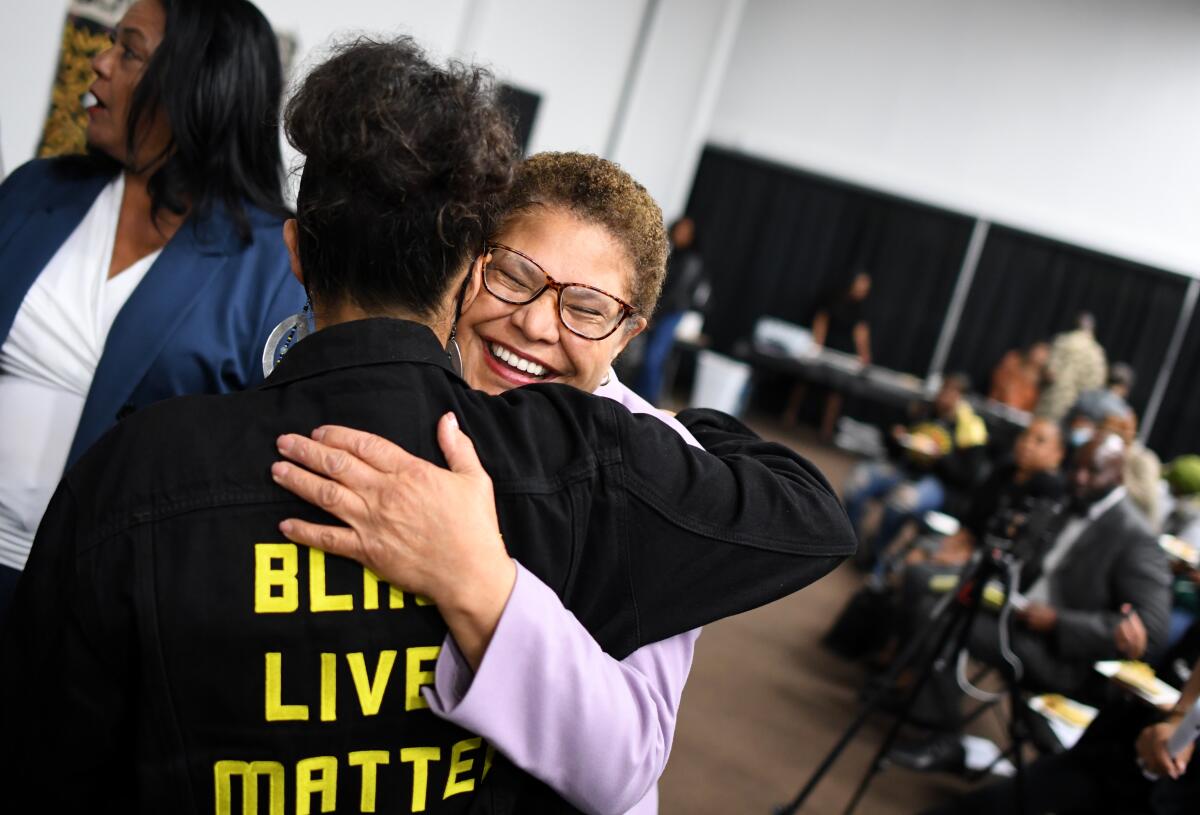L.A. on the Record: How to torpedo a police hiring plan

- Share via
Good morning, and welcome to L.A. on the Record — our City Hall newsletter. It’s David Zahniser, with major help from Julia Wick and Dakota Smith.
Get the lowdown on L.A. politics
Sign up for our L.A. City Hall newsletter to get weekly insights, scoops and analysis.
You may occasionally receive promotional content from the Los Angeles Times.
Are you an L.A. City Council member opposed to the idea of hiring more police? Do you want to push back against Mayor Karen Bass’ plan for adding 400 officers — but aren’t sure how?
If recent history is any guide, there are several ways to go about it.
The most direct approach, obviously, would be to reject the mayor’s budget outright — or at least the piece of it that involves police hiring. But that kind of in-your-face move could spark a messy veto fight. And at City Hall, there are other, more velvet ways to pare back a police hiring plan.
Consider a recent case study: When the council took up the budget last year, Mayor Eric Garcetti had been calling for the department to return to more than 9,700 officers.
The council had doubts, so it tweaked a few underlying assumptions in his spending plan.
Garcetti said the starting point for his police hiring plan would be 9,470. The council, accurately, said that number was out of date and readjusted it downward to 9,350. Bam! That cut 120 officers.
Garcetti wanted each Police Academy class to have 60 officers, totaling 780 recruits. The council had doubts about the LAPD’s chances of reaching that target, adjusting that figure downward as well. Boom! That cut another 155.
The council also can adjust the yearly attrition rate — the number of officers who retire and resign. Bass expects that figure to reach 590 next year. The council could push that number higher.
Those three types of changes could lower the overall hiring target at the LAPD, taking it well below 9,500 while also freeing up money for other programs. However, the council could also give Bass an out, putting those savings into a special account that could be tapped later in the budget year if the LAPD is successful at recruiting.
Garcetti had a tendency to roll over during these types of disagreements. He’s the mayor who called for a $13.25 minimum wage, only to switch to $15 once the council demanded more.
By the end of last year’s budget deliberations, Garcetti found that his police hiring plan had shrunk to 9,460. The council informed the LAPD that if hiring went well, it could come back to the council and ask for additional funding. That left the door open for Garcetti to get closer to his goal.
The big question now is, will Bass fight for her plan in ways that Garcetti didn’t?
Bass has made clear that police hiring is a high priority. If she prevails, she will need to show the type of oversight that ensures the LAPD and the personnel department — which has been slow to hire — deliver on her ambitious hiring goal.
Because at the end of the day, the City Council’s doubts about the Garcetti plan were correct. Hiring did turn out to be anemic. Academy classes were frequently half full. The LAPD now has about 9,100 officers, roughly 350 below the council’s more realistic target.
At Thursday’s budget hearing, you could hear the same creeping doubts as last year. Councilmember Tim McOsker asked Police Chief Michel Moore for a “reality check” on the prospects for meeting the mayor’s goal of 9,500 officers. He also questioned the likelihood of hiring 200 LAPD retirees — a key part of the Bass budget plan.
“Two hundred seems a little bit ambitious to me,” McOsker said.
Moore acknowledged that the LAPD is facing a difficult hiring environment.
“The pessimists are out there, saying, ‘You won’t get there,’” he told The Times after the meeting. “Well, we certainly won’t if we don’t try.”
Bass spokesperson Zach Seidl, asked about the council’s deliberations, said in a statement that the mayor “supports the funding allocated in her own budget.”
State of play
— POWER POLE PAYOUT: The Los Angeles Department of Water and Power will pay $38 million to settle a lawsuit stemming from the electrocution deaths of a father and daughter by a downed power line. In the wake of that lawsuit, the DWP’s five-member board grilled the utility’s top executives about hundreds of other deteriorating power poles labeled as threats to public safety. Bass sent her own list of demands to the DWP later in the week.
— GOING DOOR TO DOOR: In a related development, the DWP delivered notices to more than 3,200 homes and businesses last weekend about power poles it views as a safety risk. As of Tuesday, the largest number of high-risk poles — nearly 140 — were in Councilmember Nithya Raman’s district, which straddles the Hollywood Hills. Raman said her district already struggled with frequent power outages this year, with trees in hillside areas falling onto power lines during the recent rainstorms. “It was an issue before this story came out, and it will continue to be an issue for us,” she said.
— FRACAS IN THE 14TH: Assemblymember Wendy Carrillo entered the March 2024 race for City Council, saying she is troubled by the quality of constituent services in embattled Councilmember Kevin de León’s 14th District. De León hasn’t yet divulged his plans, but his former ally, Assemblymember Miguel Santiago, jumped into the race a few weeks back. The 14th includes all or part of downtown, Boyle Heights, El Sereno and Eagle Rock.
— VASQUEZ REDUX: College administrator Dulce Vasquez fell short in her bid to unseat Councilmember Curren Price in a South L.A. district last year. Now, she’s launched a campaign for state office, this time in the Assembly district represented by Assemblymember Reggie Jones-Sawyer. As you may recall, Jones-Sawyer is seeking to unseat Councilmember Heather Hutt in next year’s election.
— BACK AT CITY HALL: He spent more than a decade at City Hall as a top aide to former City Councilmember Herb Wesson. Now, Andrew Westall is back in the 10th District, joining the office of Councilmember Heather Hutt. Westall, an expert on redistricting and many other policy matters, will serve as Hutt’s chief deputy.
— SENTENCING SOUGHT: Federal corruption prosecutors have requested an 18-month prison sentence for Thom Peters, a former high-level lawyer in the city attorney’s office, journalist Justin Kloczko reports on his Substack. Peters admitted he “aided and abetted” an extortion scheme while overseeing civil cases for former City Atty. Mike Feuer. Peters will be sentenced May 9.
Bass and the People’s Budget
Seated in a capacious building that once housed a weapons dealer and is now a community space run by Black Lives Matter-Los Angeles, Mayor Karen Bass nodded and took notes for more than an hour Thursday night as activists presented their “People’s Budget.”
The BLM-LA-led People’s Budget LA coalition wants to dramatically defund the LAPD and reimagine community safety, putting more money into unarmed responders. Bass is on board for the latter. But her recently released spending plan also calls for more police.

During the meeting, Bass made clear that she would not back down from her goal of staffing up the LAPD. But she also spent much of the night leaning into points of potential agreement, as she discussed community investment and her new Office of Community Safety.
It’s hard to imagine such a meeting taking place during the waning days of the Garcetti administration, unless it was conducted over a bullhorn outside the mayoral residence, where BLM frequently protested. But for Bass, a longtime organizer who has known many of the community leaders in the room for decades, the meeting in Leimert Park in the heart of Black L.A. was a homecoming of sorts for the city’s second Black mayor.
The meeting was also a test for a progressive Democrat who has at times drawn fire from the left for her position on police hiring, which remains consistent from the campaign. Activist ire was also one of several factors that dimmed former Garcetti’s public image in his final years in office.
Some in the room had publicly protested Bass in the past, even disrupting mayoral forums. BLM-LA co-founder Melina Abdullah has occasionally been a vocal critic of Bass despite the pair’s long relationship. But in this more private setting, the mayor and the community activists achieved something that’s become increasingly rare in Los Angeles politics: a lengthy and respectful dialogue that continues despite fundamental disagreements on how to run the city.
“I know that’s where we don’t agree: I do call for police,” Bass said. “As mayor, I have to be mayor for the entire city. And I know what the sentiment is in this room, but it doesn’t represent the sentiment in the entire city.”
After the mayor had left and volunteers were packing up the folding chairs, Abdullah turned to someone and commented on the evening: “We can’t say she runs from us,” she said.
Enjoying this newsletter? Consider subscribing to the Los Angeles Times
Your support helps us deliver the news that matters most. Become a subscriber.
QUICK HITS
- Where is Inside Safe? Mayor Karen Bass’ program to move homeless people indoors spent a second week on the streets around the El Pueblo de Los Angeles Monument in downtown. It also ventured into South L.A., focusing on and around 110 Freeway overpasses between 42nd and Vernon streets.
- On the docket for next week: The City Council will take up its two big community plan updates — one for Hollywood, the other for downtown L.A. — on Wednesday. The two plans seek to bring more housing to some of the city’s most densely populated areas over the coming decades.
Stay in touch
That’s it for this week! Send your questions, comments and gossip to [email protected]. Did a friend forward you this email? Sign up here to get it in your inbox every Saturday morning.
Sign up for Essential California
The most important California stories and recommendations in your inbox every morning.
You may occasionally receive promotional content from the Los Angeles Times.





